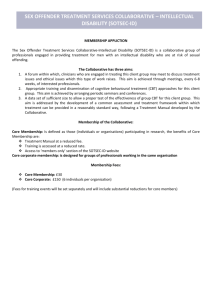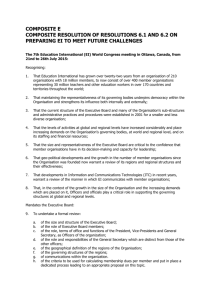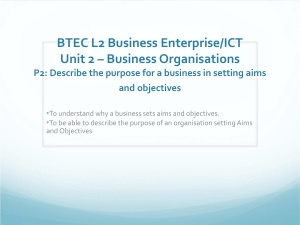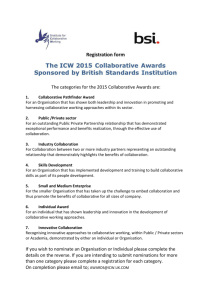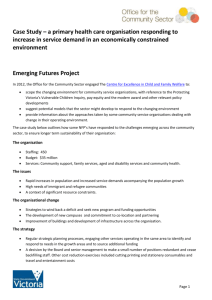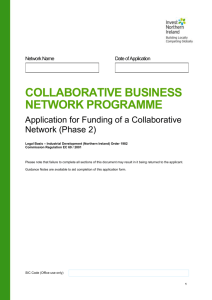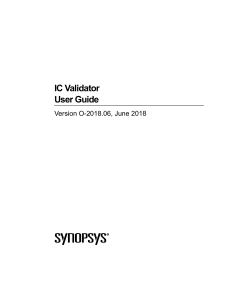Guidance for Applicants - The Education and Training Foundation
advertisement
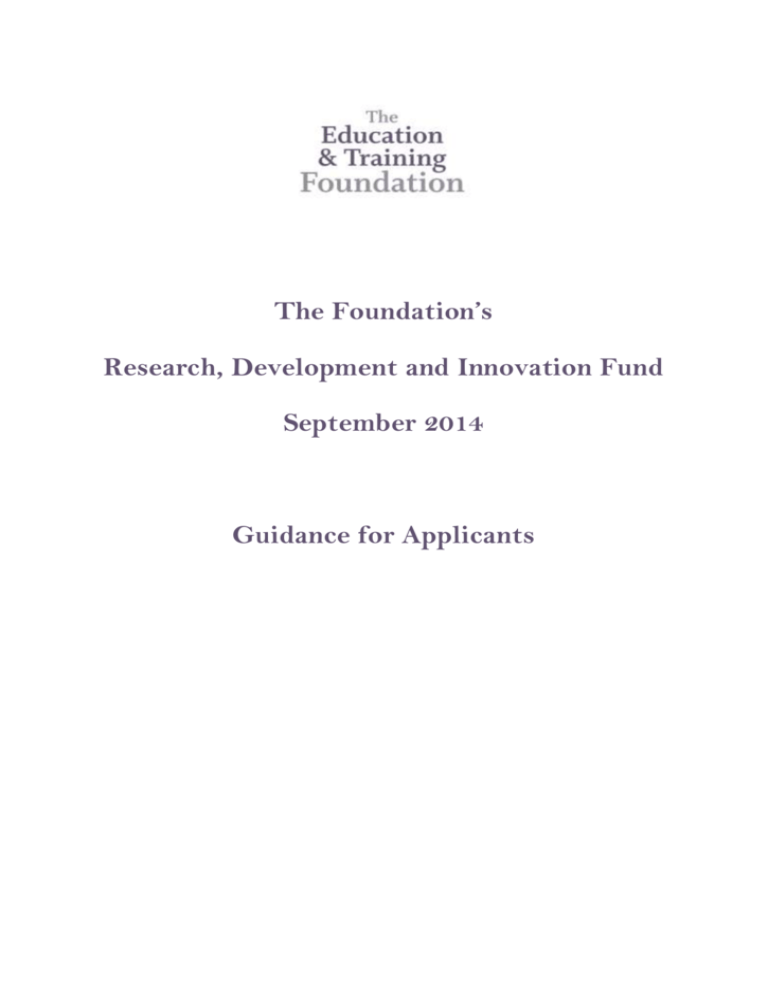
The Foundation’s Research, Development and Innovation Fund September 2014 Guidance for Applicants Table of contents 1. The Education and Training Foundation ......................................3 2. Overview of the Fund ................................................................4 3. Application Process ..................................................................6 4. Assessment Criteria ..................................................................6 12 September 2014 2/10 1. The Education and Training Foundation For a general overview of the work of The Foundation please visit the website at: www.etfoundation.co.uk/ 1.1 Background and Context The Education and Training Foundation was established on 1st August 2013 with an overarching remit to improve professionalism and standards in the Education and Training Sector. The Foundation’s central responsibility is to ensure learners benefit from the development of a wellqualified, effective and up-to-date workforce supported by good leadership, management and governance. One of the outcomes of the national consultation on the development of The Foundation was that it should ‘foster and promote professionalism to support the development of best practice through research, innovation and excellence in teaching, learning and assessment’. The government White Paper, ‘Rigour and Responsiveness in Skills’, April 20131, highlighted the important responsibility The Foundation has ‘for professionalism of the sector’ in order to ‘give the profession itself the power to raise teaching quality’ leading to the continuous improvement of standards, reputation and learner outcomes. The Foundation has been given responsibility for taking forward the recommendations from the Commission on Adult Vocational Teaching and Learning (CAVTL) report ‘It’s all about work …’2 1.2 Foundation Principles The work of The Foundation is sector led and informed by a set of principles to ensure it meets the needs and priorities of the workforce through its delivery model and operations: driven by the intended impact on the learner and learning outcomes; likely to enhance the reputation of the sector and contribute to making it a more attractive place to work; serves all parts of the sector and all types of provider; widely available across the country (England); retains and builds on existing good practices and resources; embodying equality and diversity considerations; secures best value for money; has evaluation and impact measures designed in from inception. Department Business Innovation and Skills and Department for Education, (2013), ‘Rigour and Responsiveness in Skills, ’ http://tinyurl.com/mfg5p6f 2 http://repository.excellencegateway.org.uk/fedora/objects/eg:5937/datastreams/DOC/content 1 12 September 2014 3/10 The Foundation’s Operational Plan 3 describes our strategic goals as follows: The Education and Training Foundation aims to raise the quality and professionalism of the education and training system in order to achieve consistently excellent outcomes for learners and employers. We will do this by getting behind colleges and training providers of all types and supporting them to achieve their own improvement objectives. We will also identify where the strategic challenges lie for sector improvement and lead action to address those challenges. Our top priorities in 2014 to 2016 are improving maths and English; leadership and governance; and creating a Vocational Education and Training (VET) system based on collaboration between employers and providers. Our broader agenda is to promote the effectiveness of the education and training system to employers and national influencers, and to ensure that high professional standards are set and maintained, using a sound evidence base of what works best in vocational education for learners and employers. The achievement of our goals is underpinned by a commitment to promoting and supporting evidence based practice and improvement in the sector and in our own work. Much of the work of The Foundation is procured through competitive tendering. The purpose of this fund, therefore, is to provide a complementary mechanism whereby The Foundation can encourage and support new thinking and innovative approaches to delivering its remit, and which might not emerge through our mainstream procurement route. 2. Overview of the Fund The Foundation currently has a small amount of funding available to support one or more suitable projects, and is inviting applications to its 2014 Research, Development and Innovation Fund from organisations with project and programme proposals that meet the following criteria: are able to demonstrate a positive impact on outcomes and/or learning in support of one or more of our priorities, and including the embedding of equality and diversity in our sector; have an ambitious and financially sustainable strategy (post our funding support); are supported by a competent management team who are open to challenge and support; incorporate our requirement for evidence-based improvement and practice; are from partnerships, involving more than one individual or organisation, and through which collaborative learning and development can take place; reflect our commitment to improvement through joint practice development or similar models of collaborative, research-based improvement (see Annex A); apply, where relevant, the 2014 professional standards for teachers and trainers 4; http://www.et-foundation.co.uk/our-organisation/documents/ Available here http://www.et-foundation.co.uk/supporting/programmes/professionalstandards/ 3 4 12 September 2014 4/10 rigorously measure their on-going performance and progress against our evaluation strategy’s criteria of reach, quality assurance and impact; have incorporated an external individual or organisation as an External Validator. 2.1 Timeline The projects must be completed by March 2015. Final reports from the Projects will be required by March 2015. 2.2 Eligibility The Innovation Fund is able to support Education and Training Providers, Higher Education Institutions, public services, charities, social enterprises and for profit businesses provided they can demonstrate that their projects will meet the requirements listed in this guidance note. Any number of organisations and individuals can apply together, but one must act as lead and take responsibility for the others. There should be previous experience within the team of successfully managing and delivering projects of a similar nature. While applicants can be established in any part of the UK, the benefits of their proposals should focus primarily on England. Where the lead organisation is not a College or provider operating within the Education and Training Sector, the proposal should include at least one such organisation as part of their collaborative partnership. The primary objective of the project should be to deliver innovation and new learning which is directly applicable or transferable to the Education and Training Sector in England. The organisations named in the proposal may already be engaged in collaborative development but the proposed project should be a new activity. The proposed project should not already be funded by public or other external organisations. The funds cannot be used for capital spending, to purchase staff training or qualifications, or to hire a consultant. An external organisation or individual identified as External Validator and included in the project plan and costing (see below for further information on this role). The project team and all the partner organisations agree to collaborate with one of The Foundation’s independent Programme Assessors for ongoing progress reviewing and final impact assessment. Any conflicts of interest should be declared. 12 September 2014 5/10 2.3 Validation and support Applicants must identify an external, independent organisation or individual as External Validator. Applications are required to build this role into their proposal and costing. The External Validator will support the project and its participants as a critical friend. This is likely to include activities such as ensuring that the project draws on existing evidence and research; generates and records its own evidence and learning in a systematic and cumulative way, suitable for sharing and publication and wider adoption/replication; and supporting the partners to work together as an effective community of practice/action learning set (or however the project wishes to describe itself). The External Validator will contribute to the final project report, commenting on the completed project and the learning, scope for wider adoption, value for money, and confirming the outcomes. The role could be fulfilled by organisations or individuals connected to a professional body, a university or an independent research company, or a sector membership body. We would not expect the fee for this role to be more than 10% of the value of the project. If helpful, The Foundation can provide a long list of suitable individuals and organisations, with the relevant skills and experience, for consideration. 2.4 Funding Each project will be funded up to a maximum of £25,000 payable in 2 stages: 50% on project approval by The Foundation, to support the setting up of the project 50% on project completion and final reporting to The Foundation. Should more suitable projects be received than there is currently funding to support, The Foundation will keep those proposals on a long list, in case more funding becomes available at a later date. 3. Application Process Projects should complete the application form which can be found here http://www.etfoundation.co.uk/supporting/research/rdi-fund THE CLOSING DATE FOR APPLICATIONS IS 31 OCTOBER 2014. Completed applications should be emailed to innovationfund@etfoundation.co.uk 12 September 2014 6/10 4. Assessment Criteria All applications will be assessed against the following criteria and scoring system: Assessment Criteria Maximum Score Pass/Fail 1. Eligibility Criteria Describe how your project meets each one of the eligibility criteria set out in 2.2 above. This includes listing all the partners, identifying the lead partner and also the External Validator. 2. Project Summary – Give a short summary of the project, including background to its 5 development, primary objectives and approach. 3. Alignment with Foundation Strategic Goals and Priorities 5 Describe how the project will help us deliver against these as set out in section 1 above. Our Equality and Diversity focus should also be reflected in your response along with, where relevant, how the project will promote/apply the 2014 professional standards for teachers and trainers. 4. Potential for New Learning 5 Identify why this is new work and what new learning and innovation the project is designed to deliver. How will it support of The Foundation’s goals and priorities and the Education and Training Sector’s improvement and development needs? 5. Collaborative Learning, Wider Adoption and Application 5 Describe how the project will be designed and delivered so as to apply a collaborative, research-based, model and support wider sharing and application of the learning. 6. Outputs, Reach, Impact, Quality Assurance, Sustainability 5 Identify the intended outputs and impacts and the likely reach into the sector (i.e. number of providers and practitioners). Also describe how the project will be quality assured and evaluated, and its reach and impacts captured. What is the strategy for sustainability, including financial sustainability? 7. Timetable and Costing – 5 Supply a project timetable, with key milestones including progress and final reporting to The Foundation. Identify what funding is sought 12 September 2014 7/10 from The Foundation, and how it will be used, and whether any matched funding being provided from elsewhere. Total 30 5. Legal Terms & Conditions The contract associated with this tender will be subject to The Foundations standard terms and conditions. The Standard Contract is available through mytenders and tenderers should confirm that they are in agreement with the terms in the contract in their application. Conclusion Every endeavour has been made to give applicants an accurate description of our requirements. However, applicants should make their own assessments of the methods and resources needed to meet the requirements of this opportunity. 12 September 2014 8/10 Annex A Joint Practice Development (JPD), a brief introduction JPD was defined by Michael Fielding and colleagues 5 as ‘learning new ways of working through mutual engagement that opens up and shares practices with others’. It captures a process that is truly collaborative, not one-way, and the practice is being improved not just moved from one person or place to another. Traditional approaches to CPD are largely based on transferring knowledge or ‘best practices’ from an expert to his or her audience. Research shows that this is rarely effective. By contrast, joint practice development is a process by which individuals and/or organisations learn from one another. It has three key characteristics; it: involves interaction and mutual development related to practice recognises that each partner in the interaction has something to offer and, as such, is based on the assumption of mutually beneficial learning is research-informed, often involving collaborative enquiry. Applicants can access good examples of using Joint Practice Development, for CPD, selfimprovement and organisational improvement, in the education and training sector here: http://www.excellencegateway.org.uk/node/634 and http://www.excellencegateway.org.uk/node/23561 The application of JPD is also illustrated in recent work by the RSA to support professional development in Academies 6 and similarly by the National College for Teaching and Leadership 7. Fielding M et al, ‘Factors Influencing the Transfer of Good Practice’, University of Sussex, 2005 available here: http://webarchive.nationalarchives.gov.uk/20130401151715/https://www.education.gov.uk/pub lications/eOrderingDownload/RR615.pdf.pdf 5 see page 36 http://www.thersa.org/__data/assets/pdf_file/0020/1008038/Unleashing-greatness.pdf 6 http://www.sec-ed.co.uk/best-practice/replacing-cpd-with-jpd and http://www.nationalcollege.org.uk/joint-practice-development 7 12 September 2014 9/10 157-197 Buckingham Palace Road, London, SW1W 9SP t: 0203 740 8280 www.etfoundation.co.uk The Education and Training Foundation is a company registered in England Registered address: 157 -197 Buckingham Palace Road, London, SW1W 9SP Company registration number: 08540597 Registered Charity Number 1153859 12 September 2014 10/10


